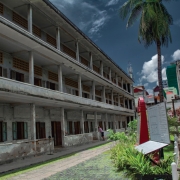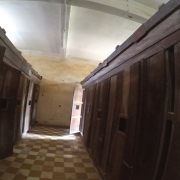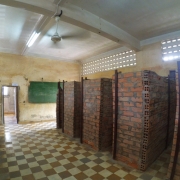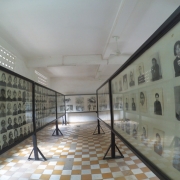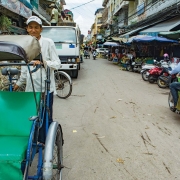
Etcetera
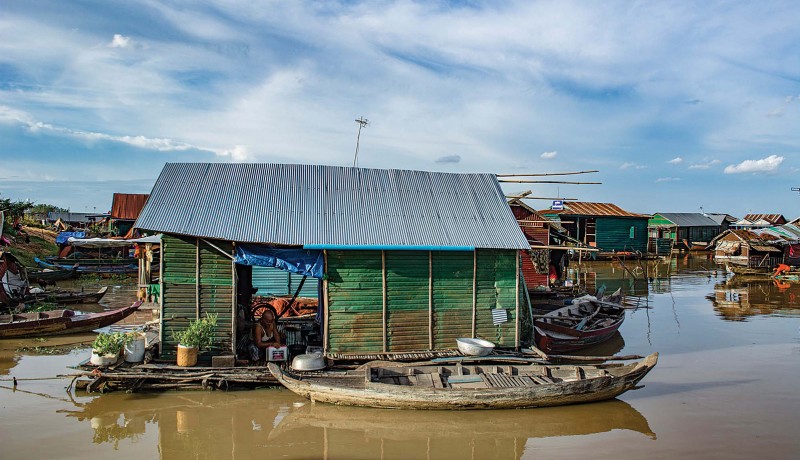
A journey through Cambodia reveals the resilience of a people who are still battling the demons of a gruesome genocide
Haunting black-and-white mugshots of Khmer Rouge victims were splattered on the walls around me. Some had broken jawbones, others missing teeth. Every time I looked at a new image, I winced. A silver standing next to me was twitching from time to time. We were at the infamous S-21 Tuol Sleng Genocide Museum in Phnom Penh, where as many as 17,000 men, women and children were imprisoned, tortured and brutally murdered.
As I gathered my thoughts, I realised the silver—a Cambodian in all probability—had not budged at all; I could find him blinking his moist eyes. Watching him, it dawned on me that I hardly knew anything about the atrocities of the Khmer Rouge, which claimed over 2 million lives in four years beginning 1975.
Getting back to the hostel, I picked up Children of Cambodia’s Killing Fields, a book gifted by a Cambodian I met in Siem Reap. It is a sad account of the survivors of the genocide. In 1975, the Khmer Rouge or the Communist Party of Kampuchea, as they officially called themselves, took over Phnom Penh and rest of the country with the goal of transforming the nation into a cashless, anti-Western, agrarian society. But this dramatic attempt at social engineering came at a terrible cost. People practising Western standards of living, including doctors, teachers and other professionals, were brutally murdered. Citizens were even condemned for wearing glasses or knowing a foreign language. Schools were turned into re-education camps and cities were vandalised. Unfortunately, many Khmer Rouge soldiers were children; their victims were children too. The government was finally overthrown in 1979 by invading Vietnamese troops. However, in a travesty of justice, Khmer Rouge leader Pol Pot, who was denounced by his former comrades in a show trial in 1997, was only sentenced to house arrest till his death in 1998.
Curious for some personal accounts, I tried quizzing the hostel staff. They seemed reluctant to discuss Khmer Rouge; probably, it was too painful for them. Next morning, I headed to S-21 Tuol Sleng once again, with a few hours planned for the Choeung Ek killing fields. Though it was still the early hours of the morning, the city of Phnom Penh looked bright and functional, with roadside stalls selling eatables and tuk-tuk drivers negotiating with customers. It’s hard to believe that the riverside of Sisowath Quay, where tourists can be seen sipping cocktails or a happy-hour 50 cent-beer today, was bombed 40 years ago. Most of the buildings in the city are brand new, but the remnants of old architecture are still visible.
The two-storey buildings of Tuol Sleng were a high school before being turned into one of the largest detention and interrogation centres under the Khmer Rouge. The classrooms were transformed into torture chambers, with each room housing more than a dozen small cells. The Spartan interrogation rooms were furnished with just a school desk-and-chair set and a steel bed frame with shackles at either end. The windows were covered with iron bars and barbed wire to prevent escapes. Upon arrival at the camp, the prisoners were photographed as evidence for Khmer Rouge leaders. The main building, notoriously known as Security Prison 21 or S-21, is where most of the heinous crimes took place. Besides photographs of victims, the rooms today display torture equipment such as iron bars and rods, pickaxes, machetes and electric wires. The inmates were tortured till they confessed to crimes they never committed. Not everyone who visits Tuol Sleng Museum can complete the entire tour; I turned out to be one among them!
Disturbed, I hired another tuk-tuk to the killing fields of Choeung Ek. As it revved up, the driver told me Choeung Ek was just one of the 150 execution centres around the country. The killing fields were used for massacre and burial of bodies. People who showed a slight hint of intellect were killed and buried there along with their family.
Walking inside a killing field literally means walking on human remains. I was careful not to step on anything that remotely looked like a bone. Listening to the audio set, which cost $ 3 on top of the entry fee, I learned that the army killed thousands by repeatedly hitting them on their faces with iron rods as bullets were expensive. Some smashed skulls on the field validate this statement.
Choeung Ek had several mass graves, separating the bodies of men, women and children. Right next to one of the graves was the ‘killing tree’, so called because its massive trunk was used to smash the heads of children before they were thrown into the mass grave. A tall 17-storey stupa, situated almost in the centre of the fields, is filled with skulls.
It is hard to believe that everybody living in Cambodia today over the age of 40 is either a victim or a perpetrator of this brutality. And even those who were not born then are indirect victims of family separation and loss. Perhaps that’s why when you ask locals about their views on Khmer Rouge, they look perplexed or agitated, not wanting to share the painful details.
Though Cambodia may well be a country still trying to find its way after the horrifying genocide, you realise it’s peopled with some of the friendliest souls on earth. As you walk along the streets of Phnom Penh, you find nothing but smiles and soft laughter. The soul of the nation, its tragic past and the cheerful people never miss leaving a mark on your heart. With cemented roads still not a reality, you’ll be travelling mostly along dirt tracks. Yet every time you go past small villages, children will wave, smile and shout a happy “hello!”
FACTFILE
WHEN TO GO
As Cambodia is warm almost year-round, with temperatures rarely dropping below 200 Celsius, the best time to visit is between November and March.
VISA & CURRENCY REQUIREMENT
Indians can get an eVisa (valid for three months) as well as visa-on-arrival (valid for one month). Visa-on-arrival costs $ 30, and can be obtained at the airport or land border. Carry a passport-sized photo and the fee, which has to be in US dollars, and you’re good to go.
The official currency is The Cambodian Riel (KHR). However, the country uses US dollars and local people are always more than willing to accept them. There’s no real need to carry the local currency unless you’re visiting villages and paying for really small things on the streets. Most ATMs in Cambodia dispense US dollars.
TIPS
There are no direct flights from India to Cambodia. You need to take a connecting flight from either Bangkok in Thailand or Kuala Lumpur in Malaysia. The two major airports of the country are Siem Reap and Phnom Penh, with most flights flying to and from the capital city of Phnom Penh. It is also possible to enter the country by land from Thailand, Vietnam and Laos.
In Phnom Penh, there’s almost no public transport. Tuk-tuks are the preferred option. To visit Tuol Sleng Genocide Museum and Choeung Ek killing fields for half a day, tuk-tuks charge somewhere around $ 40, including driving and waiting time. At Tuol Sleng Genocide Museum and Choeung Ek killing fields, tourists are given a headset guide for an additional cost of about $ 3.
Do not leave Cambodia without trying the sumptuous Khmer curry with local beer. You can enjoy a delicious meal on the street for less than $ 2, and in a restaurant for less than $ 5.
Text & Photo: Devesh Joshi Featured in Harmony — Celebrate Age Magazine May 2017
you may also like to read
-
Cracking the longevity code
Small yet impactful choices can be game-changers, writes Srirekha Pillai At 102, there’s no stopping Chandigarh-based Man Kaur, the world’s….
-
Home, not alone
While a regulatory framework is vital for senior-care facilities, the need of the hour is to develop an ecosystem to….
-
Birthday Girl
Published in a special edition to honour Japanese master storyteller Haruki Murakami’s 70th birthday, Birthday Girl (Penguin; Rs 100; 42….
-
A huge treat for music lovers
Published as the revised and updated second edition, Incomparable Sachin Dev Burman (Blue Pencil; Rs. 599; 470 pages) the authoritative….



